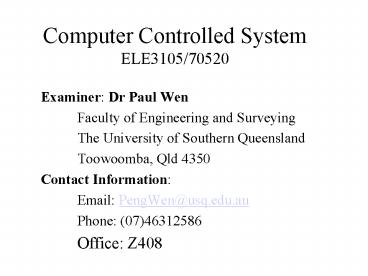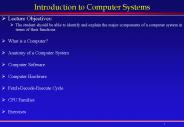Computer Controlled System ELE310570520 - PowerPoint PPT Presentation
1 / 54
Title:
Computer Controlled System ELE310570520
Description:
Textbook: 'Discrete time control system', Katsuhiko Ogata, 2nd ed. Prentice-Hall, ... 16-bits: L=216=65536 (almost overkill) 1.3 ADC and DAC. ADC ... – PowerPoint PPT presentation
Number of Views:481
Avg rating:3.0/5.0
Title: Computer Controlled System ELE310570520
1
Computer Controlled SystemELE3105/70520
- Examiner Dr Paul Wen
- Faculty of Engineering and Surveying
- The University of Southern Queensland
- Toowoomba, Qld 4350
- Contact Information
- Email PengWen_at_usq.edu.au
- Phone (07)46312586
- Office Z408
2
Study Materials
- Study Book Computer controlled systems
- Textbook Discrete time control system,
Katsuhiko Ogata, 2nd ed. Prentice-Hall, Inc.,
1995. - Support Materials Matlab ( 5.3/later Control
toolbox) - References
- Astrom K. J. Wittenmark B., Computer
controlled systems theory and design, 3rd
edition, Prentice Hall, New York, 1996. - Nagle H. Philips C., Digital control system
analysis design, Prentice Hall. - Norman S. Nise, Control system engineering
Third edition, John Wiley Sons, Inc., New York,
2000.
3
Timetable
- Note Consulting in non-consulting time
- Quick questions (5 minutes) Any time
- Others By Appointments
4
Assessment
- Students attention is drawn to the student
related policies and the unit specification 2002,
which outline the Universitys Assessment Policy
and the requirements. - For unit 70520, Computer controlled systems, you
must obtain 50 from each of three assessments
and 50 all over.
5
Assessment
6
Questions?
7
Subject Overview
Computer engineering I II
8
1.1 Introduction
- Control system definition Control system
application.
9
1.1 Introduction
- Advantages of control systems
- Power amplification
- Remote control
- Convenience
- Compensation for disturbance
10
1.1 Introduction
Control system
11
1.1 Introduction
Computer controlled system
12
1.2 Digital control loop Components
- GHP(z) is the transfer function of control object
ZOH, where z indicates the discrete time domain - GC(z) is a controller implemented in computer
languages. - A/D is the Analog-to-Digital converter (Voltage
?Binary number). - D/A is the Digital-to-Analog converter (Binary
number ? Voltage). - The little switch indicate a sampling operation.
13
1.2 Digital control loopSignals
- Discrete time domain
- R(z) is the desired output
- E(z) is the error signal
- M(z) is the controller output/control action
- C(z) is the actual output
- Continuous time domain
- In continuous time domain, R(z), E(z), M(z) and
C(z) are corresponding to r(t), e(t) m(t) and
c(t).
14
1.2 Digital control loopSequence of events
- Get desired output r(t) at this instant in time
- Measure actual output c(t)
- Calculate error e(t)r(t)-c(t)
- Derive control signal m(t) based on proper
control algorithm - Output this control signal m(t) to controlled
object - Save previous history of error and output for
later use - Repeat step 1 to 6 (go to 1)
15
1.2 Digital control loopForms of signals
- Computer cannot sample while calculating, so
there is a sample frequency 1/T for data
acquisition through a A/D, where T is sampling
interval. - The data of a signal are recorded and represented
as a sequence of number in memory. - Based on these numbers, a control signal is
derived and then conveyed to controlled object
through a D/A
16
1.2 Digital control loopForms of signals
- In between sample instants, the input is supposed
as constant and the output is held as a constant
by a device termed as zero-order-hold (ZOH). - The reconstruction of a signal will be a
stair-step, and a low-pass filter is employed to
smooth out the rough edges
17
1.3 ADC and DAC
18
1.3 ADC and DAC
D/A is used as a ZOH.
19
1.3 ADC and DACADC
- Have a discrete number of quantization levels
- Number of levels L2N, where N is the number of
bits - eg N3 bits, L238 levels
20
1.3 ADC and DACADC
21
1.3 ADC and DACADC
- More bits more accuracy. The commonly used ADC
has - 8-bits L28256 (coarse)
- 10-bits L2101024 (adequate)
- 12-bits L2124096 (works well)
- 16-bits L21665536 (almost overkill)
22
1.3 ADC and DACADC
- Distances between sequential levels are the same.
eg 5v/280.0195v - The weight of each bit is different. The most
significant bit is the most left bit and the
least significant bit is the most right bit.
23
1.3 ADC and DACADC
Example For N8, find the number range of the
ADC in binary, decimal and hexadecimal numbers.
If the input signal is from 0 to 5 voltage for
the above number range, what will be the number
for a 2 voltage signal in decimal and binary
numbers? Solution In binary 00000000B?
11111111B In decimal 0 ? 2726252423222120
255 In hexadecimal 0 ? F15 00H ?FFH
24
1.3 ADC and DACADC
Decimal to binary Exercise For N10,
repeat the above example
25
1.3 ADC and DACDAC
Example For N8 and the signal is from 0 to
5, find the output value for the number
145. Solution5/255x/145, x5145/2552.84312.84
26
1.3 ADC and DAC
Multi-channel A/D converter
27
1.3 ADC and DAC
Multi-channel D/A converter
28
1.4 Errors
29
1.4 Errors
- The quantization error or resolution error is the
difference between the analog input value and the
equivalent digital value. On average it is one
half of the LSB. - Linearity error the maximum deviation in step
size from ideal step size, expressed as a
percentage of full scale. - Settling time the time it takes for the output
to reach within /- half of the step size of the
final output.
30
1.4 Errors
- Gain error
Output
Digital
Analog
Input
31
1.5 Sampling theorem
32
1.5 Sampling theorem
33
1.5 Sampling theorem
If we need the sampled data to keep all the
features of the original signal, what is the
minimum sampling frequency? Or what conditions
should we meet if we wish that the sampled data
can represent the original data exactly? The
answer to the above question forms the Sampling
theorem/Shannons sampling theorem/Shannons
theorem.
34
1.5 Sampling theorem
A continuous-time signal f(t) with a finite
bandwidth ?0 (the highest frequency component in
the signal, or the Nyquist frequency) can be
uniquely described by the sampled signal
f(kT)k,-1,0,1., when the sampling frequency
?s is greater than 2?0. In other words, if a
signal is sampled twice faster than its highest
frequency component, the sampled date can
represent all the features of this signal.
35
1.6 The proven of sampling theorem
- The proven is based on Fourier Transform
- Fourier transform A transformation from time
domain to frequency domain f(t) ? F(?), where t
is time and ? is frequency. - For a continuous time function f(t), we can
uniquely find F(?). If given F(?), we can also
unique determine f(t). - It means that f(t) and F(?) are equivalent.
36
1.6 The proven of sampling theorem
37
1.6 The proven of sampling theorem
2. For a sampled signal fs(t), we have
38
1.6 The proven of sampling theorem
3. The relationship between f(t) and fs(t), and
F(?) and Fs(?).
39
1.6 The proven of sampling theorem
4. If we change the sampling frequency, what will
happen with fs(t) and Fs(?).
40
1.6 The proven of sampling theorem
41
1.6 The proven of sampling theorem
- 5. Conclusions
- If our sampling frequency ?s is faster enough,
that is ?sgt2?0, there will be gaps between the
shifting F(?) in Fs(?). We can always put a
filter to figure out F(?) from Fs(?). Otherwise
if the repeating F(?) figures overlap in Fs(?),
we cannot put a filter to figure out F(?) from
Fs(?). The turning point from possible to
impossible is ?s 2?0, where ?0 is the highest
frequency component or Nyquist Frequency of the
signal.
42
1.7 Aliasing
- 1. Aliasing problem
43
1.7 Aliasing
- Ambiguity alias
44
1.7 Aliasing
- 2. Finding aliases
- The fundamental alias frequency is given by
- ? (?0 ?n)mod(?s) - ?n
- where mod() means the remainder of an division
operation, ?0 is signal bandwidth, ?n Nyquist
frequency, and ?s sampling frequency - Example For f090Hz fs100, find alias.
- Solution ?2?f, fnfs/250Hz,
- f (f0 fn)mod(fs) - fn(9050)mod(100)-50
- 40-5010Hz
45
1.7 Aliasing
- 3. Preventing aliases
- Make sure your sampling frequency is greater than
twice of the highest frequency component of the
signal - Pre-filtering
- Set your sampling frequency to the maximum if
possible
46
1.7 Aliasing
- Suppose that the Nyquist frequency of a signal is
100Hz. If we use an 8-bit ADC to sample this
signal at the frequency of 200Hz, can the sample
data represents this signal exactly? Why?
47
1.7 Aliasing
- Theoretically, as long as the sampling frequency
is greater than or equal to twice the Nyquist
frequency, aliases will not happen. However,
because of the conversion/quantisation error, the
practical sampling frequency is much higher than
that (5 to 10 times of the Nyquist frequency).
Fortunately, most of the time the speeds of ADC
and computer are also much greater than signals
Nyquist frequency.
48
Reading
- Study book
- Module 1 The digital control loop
- Textbook
- Chapter 1 Introduction to discrete time
control system - Chapter 3 pages 90-92 96-98.
49
Exercise
- Exercise 1 The frequency spectrum of a
continuous-time signal is shown below. - What is the minimum sampling frequency for this
signal to be sampled without aliasing. - If the above process were to be sampled at 10
Krad/s, sketch the resulting spectrum from 20
Krad/s to 20 Krad/s.
50
Hints
The relationship between f(t) and fs(t), and F(?)
and Fs(?).
F(?)
Fourier Transform ?
?0
-?0
Fs(?)
?
-?0-?s
?0
-?0
-?0-2?s
?0?s
?02?s
-?0?s
?0-?s
?0-2?s
-?02?s
51
Answers
52
Tutorial
Solution 1) From the spectrum, we can see that
the bandwidth of the continuous signal is 8
Krad/s. The Sampling Theorem says that the
sampling frequency must be at least twice the
highest frequency component of the signal.
Therefore, the minimum sampling frequency for
this signal is 2816 Krad/s.
53
Tutorial
2) Spectrum of the sampled signal is formed by
shifting up and down the spectrum of the original
signal along the frequency axis at i times of
sampling frequency. As ?s10 Krad/s, for i 0, we
have the figure in bold line. For i1, we have
the figure in bold-dot line.
54
Tutorial
For I-1, ?2, we have






























